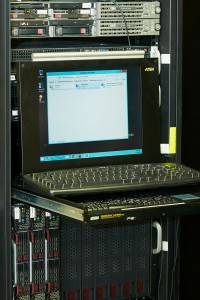Posted by: TAZ Networks on February 19, 2016 at 3:00 am
What does a small business computer network look like in 2016? While we see a lot of variety out there, we find that most businesses lean toward one of two directions:
- All items on site, under their own four walls. Businesses with this arrangement tend to feel safe and secure holding their data in-house.
- Everything in the cloud. This side of the spectrum is usually occupied by newer, younger businesses that embrace technology “whole hog.”
Is either way wrong? No, absolutely not. Usually we find that the decision is based directly on the mindset of the owners. How much risk are you willing to take? How much do you need remote access and functionality? Does your staff travel or are all folks within the same four walls day after day?
What’s involved in each network? Let’s take a peek at a couple that we would quote. In this article, we’ll address the onsite option, with all computer equipment, files, and data stored at your own location. In a future post, we’ll talk about the cloud and what equipment and services that might require.

What does the small business network of 2016 look like?
Option 1: Onsite network, at your business location.
- Firewall. Every business today needs an advanced threat firewall. A normal, low-key business firewall is no longer enough to prevent your business from getting hacked. With advanced threats such as Cryptowall and others, a firewall that scans every item going in and out of the network is a must. Our firewall of choice? The SonicWall® TZ 215 with SecureGateway enabled. Nothing is 100% but this option sure beats a lot of others out there.
- Email. One business told me they lost $20,000 in one day of inventory because their email was down. Microsoft Exchange is a powerful and reliable email platform. With Office 365, every business can have the advanced email, calendaring and contact features that Exchange provides. Office 365 also provides Sharepoint online, and file and video sharing for a low cost per user. These features all work together to boost staff productivity, which means a better bottom line for you. Office 365 starts at just $6/user per month. If you can’t justify that expense, you might need to take a better look at your business model.
- Server. HP Server hardware can be customized to your unique business needs. Depending on the size of the business we typically deploy Windows 2012 R2 Standard as the operating system. Windows is still the standard when it comes to file and print services for businesses of all sizes. Its Active Directory system is still the best on the planet. We typically deploy the Hyper-V configuration with virtualization so that we can easily add another server if necessary. This leads us to point 4.
- LOB Server. Many businesses still require a second server to run specialized applications. A virtual server saves money because you do not need additional hardware. It’s easy to deploy and administer the unique software that your vendors and suppliers require. We are seeing this setup less and less, however, as most software companies are now providing software as a service, accessed via the internet.
- Workstations. We love Lenovo computers. They are very reliable, and Lenovo stands by what they sell. However, with the quality of the PC industry today you can use just about any business-grade desktop or laptop. So, if you prefer Dell or HP, go for it. Our minimum recommendation right now is an Intel i5 processor, 8 GB of RAM, a 500 GB hard drive, and running Windows 10 Professional. Expect to pay about $700 each. Sure, it’s no $300 “Black Friday” special, but the improved reliability and performance will make you thankful you made the investment. Desktops are still a solid option, but laptops with docks allow more flexibility for travel or home-based staff. Add a set of dual monitors. (Yes, that’s two monitors per user, folks. This setup really does make people greatly more productive.) This workstation configuration should last a good 3-5 years with the proper maintenance.
- Wireless. Every office should have at least one wireless access point. This is convenient for visitors and necessary for employees who move around your facility during the work day. Larger square footage may require multiple points. We recommend the Cisco small business line. They are highly reliable and will save money over the expensive enterprise models.
- Switches. Communicating over the internet not just a fun option. More and more, it’s how companies generate revenue. Marketing, ordering, shipping – all require the internet. Switches direct the traffic between your network and the internet. They can greatly enhance communication inside and outside your office. So this is an area not to skimp on by any means. We generally use Cisco’s SG 300 line. These managed switches can monitor and prioritize traffic on your network for better efficiency and security.
That’s a quick and basic rundown of a typical onsite computer network setup. We’ll talk about cloud configurations in a future post. In the meantime, we have a ton of information about different options for cloud computing here on our web site. Click here for an overview of the benefits of cloud computing.
Are you starting up a new business venture with 10 or more on staff? Has your business grown to be ready for its first server? Is your current server getting older and slower? Fill out the contact form at the right, and we’ll be happy to discuss your options.